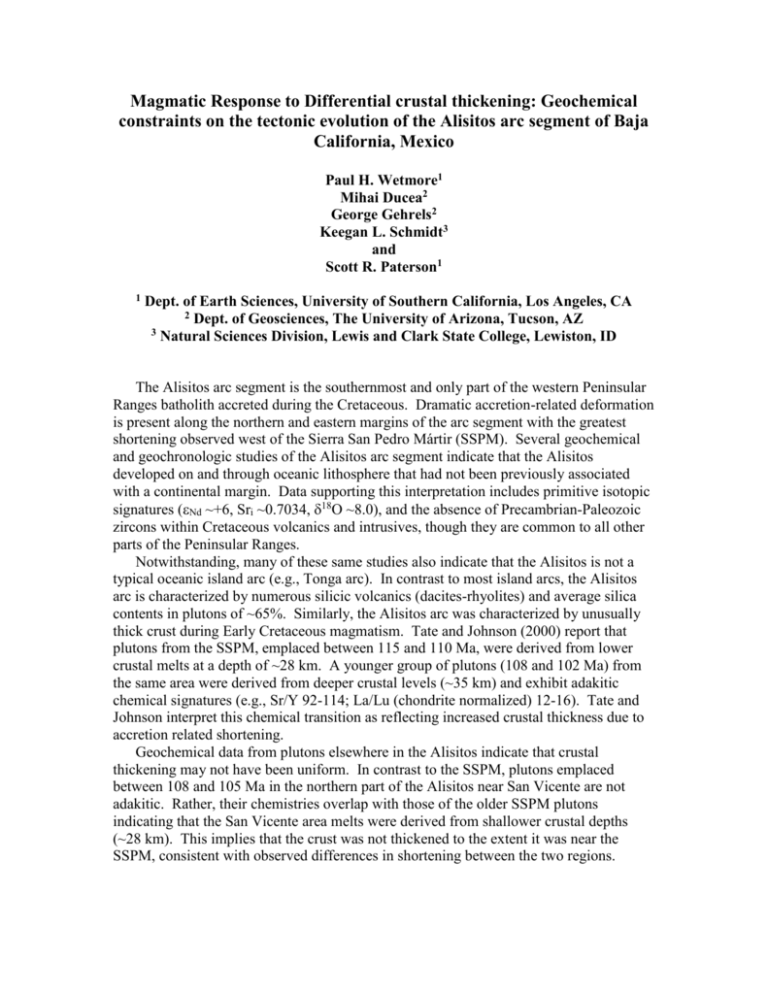Magmatic Response to Differential crustal thickening: Geochemical
advertisement

Magmatic Response to Differential crustal thickening: Geochemical constraints on the tectonic evolution of the Alisitos arc segment of Baja California, Mexico Paul H. Wetmore1 Mihai Ducea2 George Gehrels2 Keegan L. Schmidt3 and Scott R. Paterson1 1 Dept. of Earth Sciences, University of Southern California, Los Angeles, CA 2 Dept. of Geosciences, The University of Arizona, Tucson, AZ 3 Natural Sciences Division, Lewis and Clark State College, Lewiston, ID The Alisitos arc segment is the southernmost and only part of the western Peninsular Ranges batholith accreted during the Cretaceous. Dramatic accretion-related deformation is present along the northern and eastern margins of the arc segment with the greatest shortening observed west of the Sierra San Pedro Mártir (SSPM). Several geochemical and geochronologic studies of the Alisitos arc segment indicate that the Alisitos developed on and through oceanic lithosphere that had not been previously associated with a continental margin. Data supporting this interpretation includes primitive isotopic signatures (Nd ~+6, Sri ~0.7034, 18O ~8.0), and the absence of Precambrian-Paleozoic zircons within Cretaceous volcanics and intrusives, though they are common to all other parts of the Peninsular Ranges. Notwithstanding, many of these same studies also indicate that the Alisitos is not a typical oceanic island arc (e.g., Tonga arc). In contrast to most island arcs, the Alisitos arc is characterized by numerous silicic volcanics (dacites-rhyolites) and average silica contents in plutons of ~65%. Similarly, the Alisitos arc was characterized by unusually thick crust during Early Cretaceous magmatism. Tate and Johnson (2000) report that plutons from the SSPM, emplaced between 115 and 110 Ma, were derived from lower crustal melts at a depth of ~28 km. A younger group of plutons (108 and 102 Ma) from the same area were derived from deeper crustal levels (~35 km) and exhibit adakitic chemical signatures (e.g., Sr/Y 92-114; La/Lu (chondrite normalized) 12-16). Tate and Johnson interpret this chemical transition as reflecting increased crustal thickness due to accretion related shortening. Geochemical data from plutons elsewhere in the Alisitos indicate that crustal thickening may not have been uniform. In contrast to the SSPM, plutons emplaced between 108 and 105 Ma in the northern part of the Alisitos near San Vicente are not adakitic. Rather, their chemistries overlap with those of the older SSPM plutons indicating that the San Vicente area melts were derived from shallower crustal depths (~28 km). This implies that the crust was not thickened to the extent it was near the SSPM, consistent with observed differences in shortening between the two regions.










